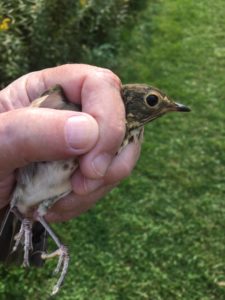Although spring is widely anticipated as prime birding season, over the years I’ve really come to appreciate autumn. At Woodland Dunes, our founder Bernie Brouchoud, spent many hours banding birds during fall, beginning with warblers in August and ending with saw-whets in late fall. He banded something like 30,000 birds at our station over a period of 50 years spending countless hours and amassing tremendous knowledge of plumages and habits of our avian visitors. Although I am licensed, I’m ashamed to say that I am only able to spend a fraction of the time Bernie did- the focus of my job pulling me constantly in other directions. Still, there are mornings when I can steal away from my desk and attempt to band a few birds.
It is hard to describe such days. The mornings are often still and damp, and the call notes emanate from the shrubs all around. If one gets out early one can hear the flight call notes from songbirds high above as they descend for the day to refuel and rest. This happens just before sunrise, and it’s magical to hear the birds high above, then suddenly in the bushes all around.
Our banding operation is a small one, just a few mist nets set in a line. After unfurling, we move a short distance away but within sight of the nets so that we can immediately retrieve any birds that are caught so they are in the nets for a very short time. They are immediately processed: banded, weighed, measured, and evaluated for fat reserves, and then released. And yes, even if we have them in our hands, some warblers are tricky to identify in fall – males, females, juveniles- so a photo is often an invaluable aid to confirming identification later on. The whole banding operation takes only a few minutes typically, but if there are several birds they are held in cloth bags for a short time. We do all we can to avoid stressing the birds. Between birds we sanitize our hands to avoid transmitting any disease.
Although banding is interesting, often the time spent waiting for birds is the most interesting, and relaxing. Sitting outdoors, with warblers and grosbeaks, catbirds and thrushes and many other songbirds plus raptors migrating overhead is amazing. Like any time spent quietly in a natural setting, it both centers us and reminds us of what really matters.
Marking birds by banding allows us to track their travels and measure their lifespans. It is a tool that allows us to further appreciate the miracles that are their lives, and remind us what we can do to ensure their survival. We need them in our lives more than ever.
Photo- a Swainson’s thrush ready for banding

